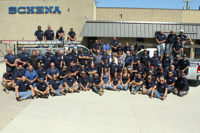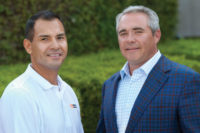Metal Makes Itself at Home
Metal
roofing may have a relatively small portion of the residential market,
but growth has been solid in that niche, and manufacturers of metal
roofing products expect to increase market share in the future. Part of
their growth strategy involves giving homeowners options beyond
standing seam roofs, including metal shingles designed to capture the
look of cedar shakes, barrel tile and natural slate.

Metal roofing may have a relatively small portion of the residential market, but growth has been solid in that niche, and manufacturers of metal roofing products expect to increase market share in the future. Part of their growth strategy involves giving homeowners options beyond standing seam roofs, including metal shingles designed to capture the look of cedar shakes, barrel tile and natural slate. “The market is still overwhelmingly vertical seam panels,” says Tom Black, executive director of the Metal Roofing Alliance. “However, the growth in modular products - standard dimensional shingles, shakes, tile, and slate - is growing significantly.”
The MRA was formed in 1999 by roofing manufacturers and their suppliers to promote the growth of metal roofing into the residential steep slope market. “Estimates of metal’s market share in the residential market prior to MRA’s formation were in the 3 percent range, with nearly all of that being in reroofing,” notes Black. “Current estimates of metal market share are at 7 percent, with reroofing around 8 percent and the new market 2 percent.”
“We believe that the long-term growth of metal in the residential market remains very healthy and will continue to outstrip overall market growth,” he continues. “Metal shingles will play an increasing role in the overall growth of metal residential roofing, especially in urban and suburban markets.”
Robinson sees the MetalWorks line as an excellent complement to the company’s other lines of roofing materials. “We expect continued growth from the MetalWorks line as the metal roofing industry grows and homeowners and building owners across the country become more familiar with the variety of metal shingle options available to them,” he says.
“The metal roofing market has seen steady growth,” agrees Meredith England, marketing specialist for DECRA, which manufactures stone-coated steel roofing. “However, in recent years, natural disasters, such as fires, have prompted the replacement of some wood shake roofs. Additionally, the enactment of more stringent building codes, focusing on more durable roofing materials, has prompted homeowners to move towards longer-lasting products for their roofs. We expect the market to continue to grow as homeowners become more educated on metal roofing and the benefits of a long-life product.”

“The role of the Metal Roofing Alliance is to educate the consumer so they consider metal when building or reroofing,” Black adds. “To do this we advertise in consumer publications and have an extensive public relations program aimed at getting consumers to the MRA Web site, www.metalroofing.com, where they can obtain a lot of generic information about metal roofing.”
Manufacturers themselves often have to tailor a more specific message. “The main misconception is that Rheinzink is used only on commercial buildings,” says Lisa Colaianni, marketing manager for Rheinzink America Inc. The company is well known for its standing seam roofing systems, but its interlocking tiles (rectangular, square and diamond) are making inroads in the residential market. “How do we get the word out?” asks Colaianni. “By using residential projects in ads as well as participating in home shows.” She points to the movement toward more ecologically friendly roofing products as a source of future growth that’s just beginning to be felt.
The beneficial effect of the “green movement” on metal roofing sales varies by market, believes Robinson, who points to California as one example. “In my opinion, the green movement will continue to play a role in increasing metal roofing sales or at least cause people to check into it further,” he states. “When addressing this issue, it is important to know that MetalWorks steel shingles are 100 percent recyclable and are made of up to 50 percent recycled material.”
In addition, Robinson points to shingle colors with a high solar reflectance that help lower energy costs. “These ‘cool roof’ colors/shingle styles are rated by the Cool Roof Rating Council (CRRC), which is a testament to the energy savings that can be achieved,” he notes.
Sustainability, a beautiful appearance, and attractive life-cycle costs are great features, and when they are topped by an excellent warranty it makes a metal roofing system that much more appealing. “The contractor is on the front line when selling any roofing product,” says England. “They need to know that the product they are selling is backed by a manufacturer that is able to answer their questions, provide training and support when needed, and stand behind their product.”
For more on metal roofing options, see our Metal Shingle Roundup.

Photo courtesy of TAMKO Building Products Inc.
Metal roofing may have a relatively small portion of the residential market, but growth has been solid in that niche, and manufacturers of metal roofing products expect to increase market share in the future. Part of their growth strategy involves giving homeowners options beyond standing seam roofs, including metal shingles designed to capture the look of cedar shakes, barrel tile and natural slate. “The market is still overwhelmingly vertical seam panels,” says Tom Black, executive director of the Metal Roofing Alliance. “However, the growth in modular products - standard dimensional shingles, shakes, tile, and slate - is growing significantly.”
The MRA was formed in 1999 by roofing manufacturers and their suppliers to promote the growth of metal roofing into the residential steep slope market. “Estimates of metal’s market share in the residential market prior to MRA’s formation were in the 3 percent range, with nearly all of that being in reroofing,” notes Black. “Current estimates of metal market share are at 7 percent, with reroofing around 8 percent and the new market 2 percent.”
“We believe that the long-term growth of metal in the residential market remains very healthy and will continue to outstrip overall market growth,” he continues. “Metal shingles will play an increasing role in the overall growth of metal residential roofing, especially in urban and suburban markets.”
A Look Ahead
Manufacturers are optimistic about the residential market. “Growth has been good,” states Neil Robinson, creative marketing director for TAMKO Building Products Inc. “Obviously, we would always like to have more, but TAMKO is pleased with the accomplishments we have made thus far, and we will continue to determine the best ways to grow this business as we move forward.” TAMKO entered the metal roofing segment in May of 2004 when it acquired the product and manufacturing line from MetalWorks, a metal roofing company located in Moon Township, Pa., and moved the line to Joplin, Mo.Robinson sees the MetalWorks line as an excellent complement to the company’s other lines of roofing materials. “We expect continued growth from the MetalWorks line as the metal roofing industry grows and homeowners and building owners across the country become more familiar with the variety of metal shingle options available to them,” he says.
“The metal roofing market has seen steady growth,” agrees Meredith England, marketing specialist for DECRA, which manufactures stone-coated steel roofing. “However, in recent years, natural disasters, such as fires, have prompted the replacement of some wood shake roofs. Additionally, the enactment of more stringent building codes, focusing on more durable roofing materials, has prompted homeowners to move towards longer-lasting products for their roofs. We expect the market to continue to grow as homeowners become more educated on metal roofing and the benefits of a long-life product.”

Photo courtesy of RHEINZINK AMERICA INC.
Educating Homeowners
Before manufacturers and contractors can explain the variety of metal products available to homeowners and discuss life-cycle costs and environmentally friendly features, they often have to overcome misconceptions about metal roofing, says Jane Swayze, director of marketing for Gerard Roofing Technologies - Metals USA Building Products. “The most common misconceptions include the thought of increased noise, that metal attracts lightning and that its appearance replicates that of barn roofs. It’s an education process to change the mindset of the consumer. We provide homeowner the facts on our Web site and literature, as well as through the efforts of the Metal Roofing Alliance, in which we are actively involved.”“The role of the Metal Roofing Alliance is to educate the consumer so they consider metal when building or reroofing,” Black adds. “To do this we advertise in consumer publications and have an extensive public relations program aimed at getting consumers to the MRA Web site, www.metalroofing.com, where they can obtain a lot of generic information about metal roofing.”
Manufacturers themselves often have to tailor a more specific message. “The main misconception is that Rheinzink is used only on commercial buildings,” says Lisa Colaianni, marketing manager for Rheinzink America Inc. The company is well known for its standing seam roofing systems, but its interlocking tiles (rectangular, square and diamond) are making inroads in the residential market. “How do we get the word out?” asks Colaianni. “By using residential projects in ads as well as participating in home shows.” She points to the movement toward more ecologically friendly roofing products as a source of future growth that’s just beginning to be felt.
The beneficial effect of the “green movement” on metal roofing sales varies by market, believes Robinson, who points to California as one example. “In my opinion, the green movement will continue to play a role in increasing metal roofing sales or at least cause people to check into it further,” he states. “When addressing this issue, it is important to know that MetalWorks steel shingles are 100 percent recyclable and are made of up to 50 percent recycled material.”
In addition, Robinson points to shingle colors with a high solar reflectance that help lower energy costs. “These ‘cool roof’ colors/shingle styles are rated by the Cool Roof Rating Council (CRRC), which is a testament to the energy savings that can be achieved,” he notes.
Sustainability, a beautiful appearance, and attractive life-cycle costs are great features, and when they are topped by an excellent warranty it makes a metal roofing system that much more appealing. “The contractor is on the front line when selling any roofing product,” says England. “They need to know that the product they are selling is backed by a manufacturer that is able to answer their questions, provide training and support when needed, and stand behind their product.”
For more on metal roofing options, see our Metal Shingle Roundup.
Looking for a reprint of this article?
From high-res PDFs to custom plaques, order your copy today!




